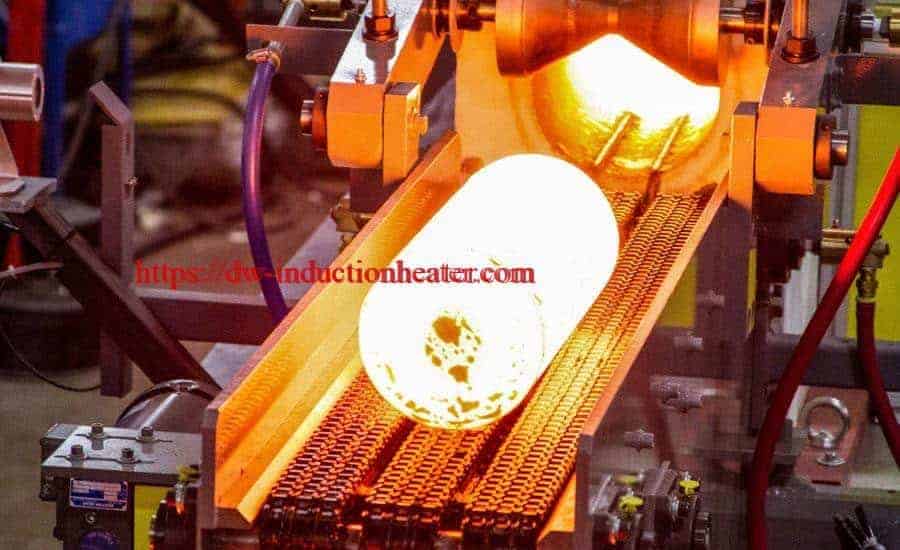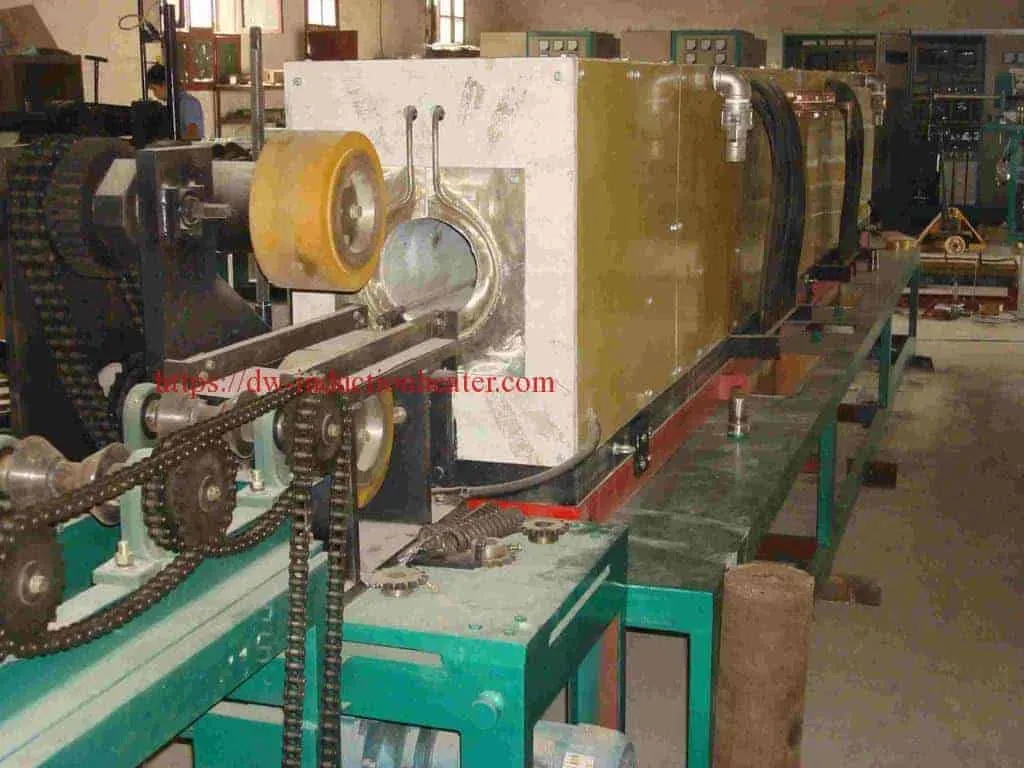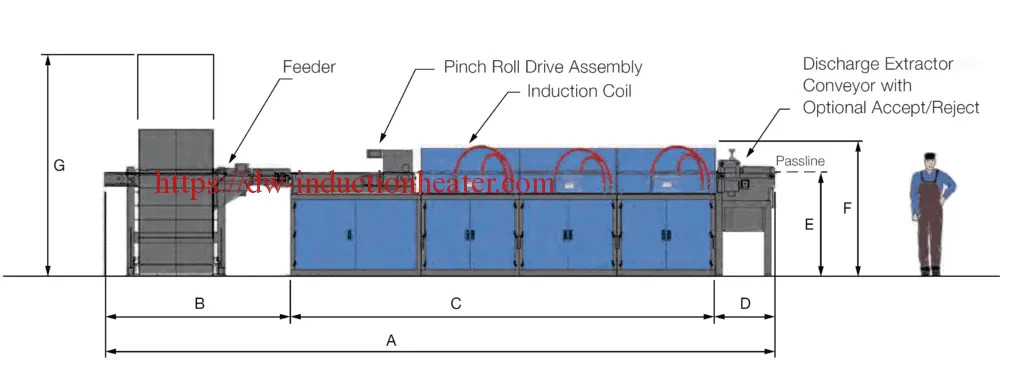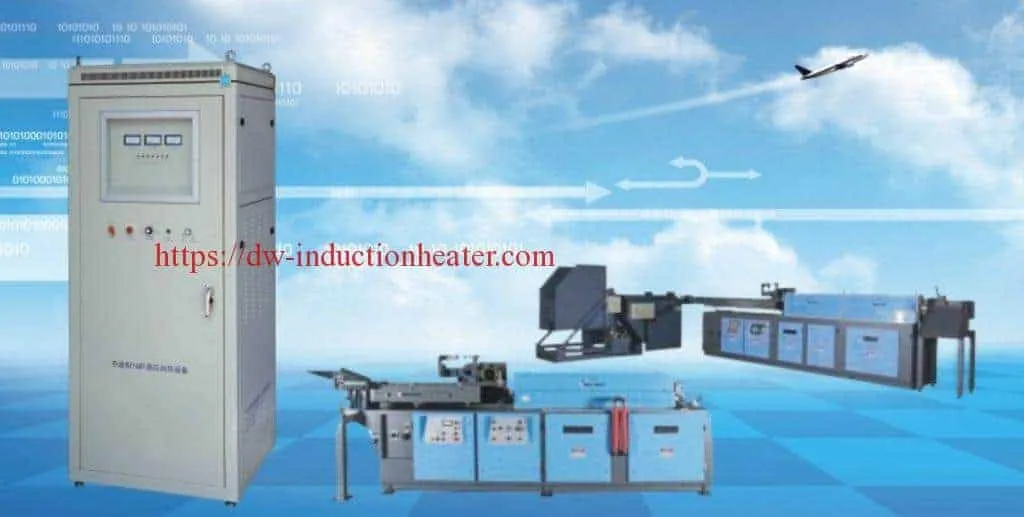
Induction Forging Bar and Billet Furnace for hot forming bars,billets and rods of aluminum,steel and copper
Induction forging bar and billet furnace is a widely used method for heating metallic objects. The process involves the use of an electromagnetic field to generate heat within the object to be heated. Induction forging is commonly used in the production of bars, billets, and rods made of various metals such as aluminum, steel, and copper. This research paper aims to explore the process of induction forging bar and billet furnace, its advantages and challenges, as well as its applications in different industries.
 Induction Forging Bar and Billet Furnace
Induction Forging Bar and Billet Furnace Process:
The induction forging process involves the use of an induction coil that produces an electromagnetic field. The bar or billet is placed inside the coil, and the alternating magnetic field induces an electrical current within the object, which generates heat due to resistance. The heat produced is proportional to the power of the electromagnetic field and the resistance of the metal being heated.
Advantages of Induction Forging Bar and Billet Furnace:
Induction forging offers several advantages over traditional heating methods. These include:
1. High efficiency: Induction forging is a highly efficient method since the heat is generated directly within the object to be heated. This eliminates the need for preheating, which reduces energy consumption and saves time.
2. Precise heating: Induction forging allows for precise control of the heating process. The heat generated can be adjusted to suit the specific requirements of the object to be heated.
3. Consistent quality: Induction forging produces a consistent quality of heat since it is generated uniformly throughout the object. This ensures that the final product is of high quality and meets the required specifications.
 Challenges of Induction Forging Bar and Billet Furnace:
Challenges of Induction Forging Bar and Billet Furnace:
Although
induction forging offers several advantages, it also presents some challenges. The following are some of the challenges associated with induction forging:
1. Limited size: Induction forging is suitable for heating small to medium-sized objects. Large objects require more power and may not be feasible with induction forging.
2. Initial cost: Induction forging requires significant initial investment in equipment and infrastructure. This makes it less suitable for small-scale operations.
3. Surface preparation: Induction forging requires the surface of the object being heated to be clean and free of impurities. This requires additional preparation time and cost.
Applications of Induction Forging Bar and Billet Furnace:
Induction forging bar and billet furnace is widely used in various industries. The following are some of the applications of induction forging:
1. Automotive industry: Induction forging is used in the production of automotive parts such as gears, axles, and crankshafts.
2. Aerospace industry: Induction forging is used in the production of components for aerospace vehicles like aircraft, space shuttles and satellites.
3. Construction industry: Induction forging is used in the production of reinforcing bars, bolts, and nuts used in construction.
 Product Description
Product Description
For heating various of bar materials: such as steel & iron, bronze, brass, aluminum alloy, etc.
Picture just for reference, color is changable with different power.
Functions and special specifications customized by customer's requirements.
Features and Advantages:
1.Automatic:Automatic feeding, automatic selection of the work-piece is good or bad, automatic measurement of temperature, automatic discharge.
2. Integrated design: Save installation time,cost and space.
3. Operation panel embedded displays machine operating states, to facilitate fault diagnosis.
| |
Features |
Detail |
| 1 |
Heating fast and stable |
saving 20%- 30% electric energy than traditional way;
High efficiency and low energy consumption |
| 2 |
Small in size |
Easy to install, operate and repair |
| 3 |
Safe and reliable |
No high voltage, very safe to your workers. |
| 4 |
A cooling circulation system |
Able to operate continuously 24 hours |
| 5 |
complete self-protect
function |
many types of alarm lamps:
over-current, over-voltage, over hot, water shortage etc. These lamps can control and protect machine. |
| 6 |
Environmental protection |
Almost no oxide layer,
produced no exhaust, no waste-water |
| 7 |
IGBT Type |
Avoid the interruption of unrelated electric net;
Ensure the long-life of the machine. |
Parameter of metals billet hot forging furnace:
|
DW-MF-200 |
DW-MF-250 |
DW-MF-300 |
DW-MF-400 |
DW-MF-500 |
DW-MF-600 |
| Input Voltage |
3phases, 380V/410V/440V , 50/60Hz |
| Max Input Current |
320A |
400A |
480A |
640A |
800A |
960A |
| Oscillating frequency |
0.5KHz^20KHz ( Oscillating frequency will be customized according to the size of heating parts) |
| Duty Cycle Loading |
100%,24h continuously work |
| Cooling Water Desires |
0.1MPa
|
| Dimension |
Host |
1000X800X1500mm |
1500X800X2800mm |
850X1700X1900mm |
| Extension |
extension will be customized according to the material and size of heating parts |
| Weight |
110kg |
150kg |
160kg |
170kg |
200kg |
220kg |
| Depend on the dimension of extension |
In the induction metals billet hot forging furnace the whole of the billets or slug is heated. Normally for short billets or slugs a hopper or bowl is used to automatically present the billets in line to pinch rollers, chain driven tractor units or in some cases pneumatic pushers. The billets are then driven through the coil one behind the other on water cooled rails or ceramic liners are used through the coil bore which reduce friction and prevent wear. The length of the coil is a function of the required soak time, the cycle time per component and the length of the billet. In high volume large cross section work it is not unusual to have 4 or 5 coils in series to give 5 m (16 ft) of coil or more.

Conclusion:
Induction forging bar and billet furnace is a highly efficient and precise method for heating metallic objects. Although it presents some challenges, it remains a popular method in various industries, including the automotive, aerospace, and construction industries. The benefits of induction forging include its high efficiency, precise heating, and consistent quality. Thus, it can be concluded that induction forging is a valuable and effective process for the metalworking industry.
 https://dw-inductionheater.com/product/induction-forging-bar-and-billet-furnace?feed_id=195163&_unique_id=64367708dfbf0
https://dw-inductionheater.com/product/induction-forging-bar-and-billet-furnace?feed_id=195163&_unique_id=64367708dfbf0

 Induction Forging Bar and Billet Furnace Process:
The induction forging process involves the use of an induction coil that produces an electromagnetic field. The bar or billet is placed inside the coil, and the alternating magnetic field induces an electrical current within the object, which generates heat due to resistance. The heat produced is proportional to the power of the electromagnetic field and the resistance of the metal being heated.
Advantages of Induction Forging Bar and Billet Furnace:
Induction forging offers several advantages over traditional heating methods. These include:
1. High efficiency: Induction forging is a highly efficient method since the heat is generated directly within the object to be heated. This eliminates the need for preheating, which reduces energy consumption and saves time.
2. Precise heating: Induction forging allows for precise control of the heating process. The heat generated can be adjusted to suit the specific requirements of the object to be heated.
3. Consistent quality: Induction forging produces a consistent quality of heat since it is generated uniformly throughout the object. This ensures that the final product is of high quality and meets the required specifications.
Induction Forging Bar and Billet Furnace Process:
The induction forging process involves the use of an induction coil that produces an electromagnetic field. The bar or billet is placed inside the coil, and the alternating magnetic field induces an electrical current within the object, which generates heat due to resistance. The heat produced is proportional to the power of the electromagnetic field and the resistance of the metal being heated.
Advantages of Induction Forging Bar and Billet Furnace:
Induction forging offers several advantages over traditional heating methods. These include:
1. High efficiency: Induction forging is a highly efficient method since the heat is generated directly within the object to be heated. This eliminates the need for preheating, which reduces energy consumption and saves time.
2. Precise heating: Induction forging allows for precise control of the heating process. The heat generated can be adjusted to suit the specific requirements of the object to be heated.
3. Consistent quality: Induction forging produces a consistent quality of heat since it is generated uniformly throughout the object. This ensures that the final product is of high quality and meets the required specifications.
 Challenges of Induction Forging Bar and Billet Furnace:
Although induction forging offers several advantages, it also presents some challenges. The following are some of the challenges associated with induction forging:
1. Limited size: Induction forging is suitable for heating small to medium-sized objects. Large objects require more power and may not be feasible with induction forging.
2. Initial cost: Induction forging requires significant initial investment in equipment and infrastructure. This makes it less suitable for small-scale operations.
3. Surface preparation: Induction forging requires the surface of the object being heated to be clean and free of impurities. This requires additional preparation time and cost.
Applications of Induction Forging Bar and Billet Furnace:
Induction forging bar and billet furnace is widely used in various industries. The following are some of the applications of induction forging:
1. Automotive industry: Induction forging is used in the production of automotive parts such as gears, axles, and crankshafts.
2. Aerospace industry: Induction forging is used in the production of components for aerospace vehicles like aircraft, space shuttles and satellites.
3. Construction industry: Induction forging is used in the production of reinforcing bars, bolts, and nuts used in construction.
Challenges of Induction Forging Bar and Billet Furnace:
Although induction forging offers several advantages, it also presents some challenges. The following are some of the challenges associated with induction forging:
1. Limited size: Induction forging is suitable for heating small to medium-sized objects. Large objects require more power and may not be feasible with induction forging.
2. Initial cost: Induction forging requires significant initial investment in equipment and infrastructure. This makes it less suitable for small-scale operations.
3. Surface preparation: Induction forging requires the surface of the object being heated to be clean and free of impurities. This requires additional preparation time and cost.
Applications of Induction Forging Bar and Billet Furnace:
Induction forging bar and billet furnace is widely used in various industries. The following are some of the applications of induction forging:
1. Automotive industry: Induction forging is used in the production of automotive parts such as gears, axles, and crankshafts.
2. Aerospace industry: Induction forging is used in the production of components for aerospace vehicles like aircraft, space shuttles and satellites.
3. Construction industry: Induction forging is used in the production of reinforcing bars, bolts, and nuts used in construction.
 Product Description
For heating various of bar materials: such as steel & iron, bronze, brass, aluminum alloy, etc.
Picture just for reference, color is changable with different power.
Functions and special specifications customized by customer's requirements.
Features and Advantages:
1.Automatic:Automatic feeding, automatic selection of the work-piece is good or bad, automatic measurement of temperature, automatic discharge.
2. Integrated design: Save installation time,cost and space.
3. Operation panel embedded displays machine operating states, to facilitate fault diagnosis.
Product Description
For heating various of bar materials: such as steel & iron, bronze, brass, aluminum alloy, etc.
Picture just for reference, color is changable with different power.
Functions and special specifications customized by customer's requirements.
Features and Advantages:
1.Automatic:Automatic feeding, automatic selection of the work-piece is good or bad, automatic measurement of temperature, automatic discharge.
2. Integrated design: Save installation time,cost and space.
3. Operation panel embedded displays machine operating states, to facilitate fault diagnosis.
 Conclusion:
Induction forging bar and billet furnace is a highly efficient and precise method for heating metallic objects. Although it presents some challenges, it remains a popular method in various industries, including the automotive, aerospace, and construction industries. The benefits of induction forging include its high efficiency, precise heating, and consistent quality. Thus, it can be concluded that induction forging is a valuable and effective process for the metalworking industry.
Conclusion:
Induction forging bar and billet furnace is a highly efficient and precise method for heating metallic objects. Although it presents some challenges, it remains a popular method in various industries, including the automotive, aerospace, and construction industries. The benefits of induction forging include its high efficiency, precise heating, and consistent quality. Thus, it can be concluded that induction forging is a valuable and effective process for the metalworking industry.
 https://dw-inductionheater.com/product/induction-forging-bar-and-billet-furnace?feed_id=195163&_unique_id=64367708dfbf0
https://dw-inductionheater.com/product/induction-forging-bar-and-billet-furnace?feed_id=195163&_unique_id=64367708dfbf0
